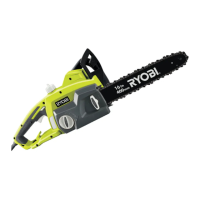10
not fall in the desired direction or it may rock back and
bind the saw chain, stop cutting before the felling back
cut is complete and use wedges of wood, plastic or
aluminium to open the cut and drop the tree along
the desired line off all. When the tree begins to fall
remove the chain saw from the cut, stop the motor,
put the chain saw down, and then use the retreat path
planned. Be alert for overhead limbs falling and watch
your footing.
■ Limbing a tree (Fig. 11)
Limbing is removing the branches from a fallen tree.
When limbing, leave larger lower limbs to support the
log off the ground. Remove the small limbs in one cut.
Branches under tension should be cut from the bottom
up, to avoid binging the chain saw.
■ Bucking a log (Fig.12 -15) Bucking is cutting a log into
lengths. It is important to make sure your footing is
firm and your weight is evenly distributed on both feet.
When possible the log should be raised and supported
by the use of limbs, logs or chocks.
Follow the simple direction for easy cutting:
a. When the log is supported along the entire length, it is
cut from the top (overbuck). (Fig.12)
b. When the log is supported on one end, cut 1/3 of the
diameter from the underside (underbuck). Then make
the nished cut by overbucking to meeting the rst cut.
(Fig. 13)
c. When the log is supported on both ends, cut 1/3 of
that diameter from the top(overbuck). Then make the
nished cut by underbucking the lower 2/3 to meet the
rst cut. (Fig. 14)
d. When bucking on a slope always stand on the uphill
side of the log. When cutting through, to maintain
complete control, release the cutting pressure near the
end of the cut without relaxing your grip on the chain
saw handles. (Fig. 15).
Do not let the chain contact the ground. After completing
the cut, wait for the saw chain to stop before you move
the chain saw. Always stop the motor before moving from
tree to tree.
MAINTENANCE
(Fig. 16-21)
CHAIN SHARPENING
When the chain penetrates into wood with difcultly, it
needs sharpening as follows:
■ Put the chain under tension.
■ Fasten the bar in a vice so that the chain can slide.
■ Fasten the file to the file holder and place it on cutter
at a 35° angle.
■ File with forward strokes only until all the worn out part
of the cutting edge is taken away.
■ Count the number of strokes given to the cutter taken
as a reference basis and file away for the same
number of strokes on all other cutters.
■ If after sharpening a few times, the depth gauge
protrudes from the template, you must reset its level
use a flat file.
■ Finally, round off the depth gauge.
NOTE: We advise you to have the deep or important
sharpening carried out by a service agent who is equipped
with electric sharpener.
GUIDE BAR MAINTENANCE
■ When you have finished working, clean out the groove
and the oil passages, with a scraping hook.
■ Periodically trim the sides of rails using a flat file.
■ If not done in the long run, the featheredges might
break away and damage the bar.
■ If one rail is higher than the other one, it is necessary
to make it even with a flat file and then smooth them
with a file or fine grain abrasive paper.
ACCESSORIES OR REPAIR PARTS
Use only genuine Ryobi accessories or repair parts. If you
need any accessories, check with your dealer. The main
accessories (Chain & Bar) are listed in the specications
section earlier in this manual.
Model Chain & Bar
RCS1835
Carlton Chain N1C-BL-52E SK B
& Carlton Bar 14-10W-MHC UNB Y
Oregon Chain 91PJ052X
& Oregon Bar 140SDEA041
Oregon Chain 91PJ052X
& Carlton Bar 14-10W-MHC UNB Y
Tri-link Chain JL9d-3 x 52
& Tri-link Bar DCR14B-050-3/8LP-52-B

